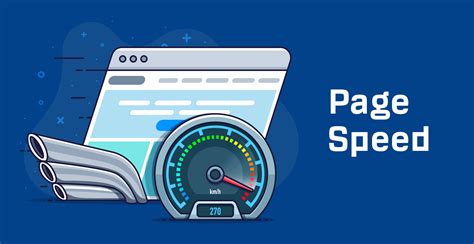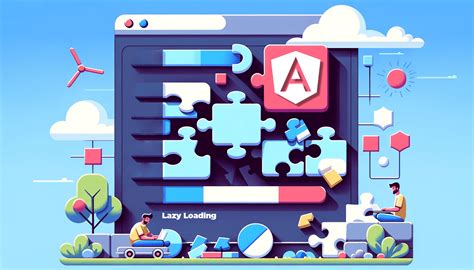As technology evolves and the digital landscape becomes increasingly competitive, the importance of delivering a seamless online experience cannot be overstated. Users have come to expect fast-loading websites that not only captivate their attention but also provide the necessary information or services efficiently. In today's fast-paced world, every second counts, and a slow website can quickly lead to frustrated users and lost opportunities.
When it comes to optimizing website performance, there are numerous factors to consider. One crucial aspect that directly impacts user experience is the speed at which a website loads. A website that takes too long to load not only tests the patience of its visitors but also loses their interest and drives them away. In contrast, a website that loads quickly not only leaves a positive impression but also keeps users engaged and encourages them to explore further.
So, how can website owners ensure their sites load quickly and provide an optimal user experience? Implementing various techniques and best practices, such as optimizing images, leveraging browser caching, minifying CSS and JavaScript files, and utilizing content delivery networks (CDNs), can significantly improve website loading speed. By reducing the bandwidth needed to load the website and minimizing the number of round trips between the browser and the server, these optimizations contribute to a faster and smoother user experience.
Optimizing images is an essential step in speeding up website loading time. By resizing and compressing images without compromising their quality, website owners can significantly reduce file sizes and enhance performance. Using modern image formats, such as WebP, and lazy-loading images that are below the fold can also contribute to faster load times.
Leveraging browser caching is another effective technique. By setting proper cache control headers and specifying cache expiration times, website owners can instruct browsers to store certain files locally. This way, when users revisit the website, the files can be retrieved from their local cache, resulting in faster page loading speed and reduced server load.
Furthermore, minifying CSS and JavaScript files eliminates unnecessary whitespace, comments, and code, reducing their file size. This optimization technique not only speeds up loading times but also enhances website security and improves compatibility across browsers.
One advanced strategy for improving website loading speed is utilizing content delivery networks (CDNs). CDNs distribute a website's files across a network of servers located in various geographical locations. By hosting website content closer to the user, CDNs minimize latency and reduce the time it takes to retrieve data, resulting in faster website performance and a more satisfying user experience.
Optimize Images for Faster Loading Speed

Images are an essential component of any website, adding visual appeal and engaging users. However, if not optimized properly, they can significantly impact the loading speed of a webpage. In this section, we will explore techniques to ensure that your images are optimized for faster loading speed without compromising the overall user experience.
Compressing Images: One of the key strategies to improve loading speed is by compressing images. Compressing images reduces their file size while maintaining acceptable visual quality. There are various tools and software available that can help in this process, ensuring that your website loads quickly and efficiently.
Choosing the Right Format: The choice of image format can also have an impact on loading speed. Different formats, such as JPEG, PNG, and GIF, have their own advantages and disadvantages. Understanding when to use each format and optimizing images accordingly can significantly enhance your website's speed.
Resizing Images: Another effective technique is to resize images appropriately for your website. Often, oversized images are uploaded, resulting in unnecessary load times. By resizing images to fit the required dimensions, you can reduce their file size and improve loading speed.
Lazy Loading: Implementing lazy loading is a smart strategy to optimize image loading speed. With lazy loading, images are only loaded as the user scrolls down the webpage. This ensures that only the necessary images are loaded initially, reducing the overall load time.
Image Caching: Enabling image caching can significantly enhance the loading speed of your website. When an image is cached, it is stored locally on the user's device, eliminating the need to download it again during subsequent visits. This results in quicker load times and a smoother user experience.
Alt Text Optimization: While optimizing images for loading speed is important, it is equally crucial to provide meaningful alt text. Alt text not only improves accessibility but also helps search engines understand the content of the image. By optimizing alt text, you can ensure that your website remains user-friendly and search engine optimized.
By implementing these optimization techniques, you can improve the loading speed of your website without compromising the visual appeal or user experience. Remember, efficient image optimization plays a vital role in enhancing the overall performance of your website.
Optimizing Website Performance by Reducing HTTP Requests
An effective strategy for enhancing your website's overall performance involves minimizing the number of HTTP requests it makes. By reducing the amount of information the web server needs to retrieve, the website's loading speed can be significantly improved, consequently enhancing the user experience.
One tactic to achieve this optimization is through combining files. Rather than having multiple separate CSS and JavaScript files, merging them into one consolidated file reduces the number of requests needed to load the website. This can be accomplished by manually combining the files or using a build tool that automates the process.
Another technique is utilizing CSS sprites. Instead of loading each individual image separately, CSS sprites consolidate multiple images into a single image file. By using CSS background positioning, specific segments of the image can be displayed accordingly. This reduces the number of HTTP requests, resulting in a faster loading time.
Caching is yet another effective method. Setting up caching mechanisms enables the web browser to store certain files locally on the user's device. When the user revisits the website, the browser can retrieve these cached files instead of making additional HTTP requests. This considerably improves the loading speed, providing a smoother browsing experience.
- Optimize images: Compress images to reduce file size without compromising quality. Use specific formats such as WebP or JPEG-XR that offer better compression.
- Lazy loading: Implement lazy loading techniques for images and videos, enabling content to be loaded only when it becomes visible in the viewport.
- Minify and compress files: Remove unnecessary whitespace and comments from CSS and JavaScript files, and compress them to reduce file sizes.
- Content Delivery Network (CDN): Utilize a CDN to distribute website files across multiple servers geographically, ensuring faster retrieval times for users located in different regions.
- Reduce redirects: Minimize the number of redirects as each redirect triggers an additional HTTP request and can slow down the website load time.
Implementing these strategies to minimize HTTP requests can significantly enhance your website's loading speed, providing users with a seamless browsing experience. By proactively optimizing the performance of your website, you can increase user engagement, reduce bounce rates, and ultimately achieve greater success online.
Boost Website Performance with Effective Caching Strategies

In today's tech-driven world, addressing slow website loading speeds and optimizing user experience are paramount. One powerful technique that can significantly contribute to these goals is caching. By intelligently implementing caching mechanisms, you can enhance the performance of your website and provide a seamless browsing experience for your users.
Leveraging caching to optimize loading speed
One key aspect of caching involves temporarily storing data or content that is frequently accessed, such as images, stylesheets, and JavaScript files. By caching these resources, the website can reduce server response time and improve loading speed, resulting in a faster and more efficient browsing experience for users.
The benefits of browser caching
Browser caching is a fundamental caching technique that relies on the ability of web browsers to store and retrieve data locally. When a user visits a website, the browser stores certain elements of the page, including CSS files, images, and JavaScript, in its cache. Subsequent visits to the same website enable the browser to retrieve these cached elements rather than requesting them from the server again. This not only minimizes the load on the server but also significantly improves the loading speed for returning visitors.
Utilizing CDN caching for improved website performance
An additional advantageous caching strategy is using a Content Delivery Network (CDN). A CDN acts as an intermediary between the origin server and the user, serving as a network of servers located in strategic locations worldwide. By caching website content in multiple servers across different regions, CDNs enhance loading speed by reducing the geographic distance between users and the server. This ensures that users experience fast load times regardless of their location.
Implementing dynamic caching for personalized content
Dynamic caching techniques come into play when a website delivers personalized or dynamic content, such as user-generated data or frequently updated information. With dynamic caching, specific parts of a webpage can be cached or pre-generated to ensure quick access for subsequent visitors. This allows websites to attain a fine balance between personalized content and optimized loading speed, catering to both user preferences and performance requirements.
Conclusion
Embracing caching strategies enables website owners to unlock the potential for enhanced loading speed, an essential factor in delivering a top-notch user experience. By leveraging browser caching, CDN caching, and dynamic caching techniques, you can significantly boost your website's performance, decrease page load times, and ultimately leave visitors satisfied with a seamless browsing experience.
Optimize Server Response Time for Quicker Website Loading
In the realm of website optimization, one crucial factor that greatly contributes to an enhanced user experience is the server response time. This refers to the time it takes for a web server to respond to a request made by a user's browser. A faster server response time can significantly reduce the loading time of a website, ensuring that visitors are not kept waiting and can access the desired content promptly.
Reducing server response time involves various strategies that optimize the communication between the server and the browser. By implementing these techniques, website owners can enhance their site's performance and improve the overall user experience. Here are some effective approaches to consider:
- Implement Server-Side Caching: By storing frequently accessed data in a cache, server response time can be significantly reduced. This allows the server to deliver the requested information quickly without retrieving it from its original source repeatedly.
- Utilize Content Delivery Networks (CDNs): CDNs distribute website content across multiple servers located in different geographic regions. This enables users to access the content from a server that is physically closer to them, reducing latency and improving the overall response time.
- Optimize Database Queries: Ensuring efficient database queries plays a crucial role in reducing server response time. This can be achieved by using appropriate indexing, minimizing unnecessary data retrieval, and optimizing query execution.
- Enable Gzip Compression: Compressing files before sending them to the browser can greatly reduce the server response time. Gzip compression reduces the size of data transferred, resulting in faster loading times for web pages.
- Upgrade Server Hardware: In some cases, improving server response time may require upgrading the server hardware. A more powerful server can handle incoming requests more efficiently, resulting in faster response times.
- Minimize HTTP Requests: Each component of a web page (such as images, scripts, and stylesheets) requires a separate HTTP request. By reducing the number of these requests, the server response time can be decreased, leading to quicker website loading.
By implementing these strategies and optimizing server response time, website owners can ensure that their websites load quickly, providing visitors with a seamless and enjoyable browsing experience. Prioritizing server response time optimization is a vital step towards enhancing user satisfaction and increasing website engagement.
Implementing Lazy Loading to Enhance User Engagement

In the age of fast-paced digital experiences, optimizing web page loading times has become crucial for attracting and retaining users. One effective strategy to achieve this is by incorporating lazy loading into your website. By strategically delaying the loading of non-essential content, lazy loading improves user engagement and overall browsing experience.
What is lazy loading?
Lazy loading is a technique that defers the loading of non-critical content until it becomes visible in the user's viewport. Instead of loading all resources at once, lazy loading prioritizes the loading of necessary elements, such as text and images, while postponing the loading of less essential content, like videos or off-screen images.
The benefits of lazy loading:
1. Faster initial page load: By only loading the essential content initially, lazy loading reduces the initial page load time, enabling users to access and interact with the website more quickly.
2. Improved user experience: With lazy loading, users no longer have to wait for the entire page to load before they can start consuming the content. They can begin reading or viewing the visible elements, resulting in a seamless and engaging user experience.
3. Reduced bandwidth consumption: By delaying the loading of non-visible content, lazy loading minimizes the amount of data transferred, leading to lower bandwidth consumption. This is particularly beneficial for users with limited internet bandwidth or those accessing the website on mobile devices.
Implementing lazy loading:
There are various ways to implement lazy loading on your website. One approach is to use JavaScript libraries or frameworks specifically designed for lazy loading, such as LazyLoad, Lozad, or Intersection Observer. These tools provide easy-to-use functions and event listeners that enable you to selectively load content as it becomes visible on the screen.
Final thoughts
By implementing lazy loading, you can significantly enhance user engagement on your website. Faster loading times, improved user experience, and reduced bandwidth consumption are just a few of the benefits that come with this technique. Consider incorporating lazy loading into your web development strategy to optimize your website's performance and ensure a positive user experience.
FAQ
How can I improve the loading speed of my website?
To improve the loading speed of your website, you can start by optimizing and compressing your images, minimizing HTTP requests, enabling browser caching, reducing the use of external scripts, and using a content delivery network (CDN).
What is the impact of website loading speed on user experience?
Website loading speed has a significant impact on user experience. Faster loading times lead to lower bounce rates, higher user engagement, improved conversion rates, and overall positive user satisfaction.
Why is it important to enhance the user experience of a website?
Enhancing the user experience of a website is crucial because it directly affects user satisfaction, conversion rates, and ultimately, the success of your online business. A positive user experience helps to build trust, encourages user loyalty, and increases the chances of users returning to your website.
What are some common factors that slow down website loading times?
Some common factors that slow down website loading times include large image files, excessive HTTP requests, unoptimized code and scripts, lack of browser caching, heavy use of Flash and other plugins, and hosting on a slow server.
How can using a content delivery network (CDN) help improve website loading speed?
A content delivery network (CDN) can improve website loading speed by storing your website's files on multiple servers located across different geographic locations. This allows users to access your website from a server that is closest to their location, minimizing latency and reducing the time it takes for your website to load.
Why is website loading speed important?
Website loading speed is important because it directly impacts user experience. Slow loading websites can frustrate users and lead to high bounce rates. Additionally, search engines like Google consider loading speed as a ranking factor, so a slow website may also affect its visibility in search results.
What are some factors that can affect website loading speed?
Several factors can affect website loading speed. Firstly, the size of images and multimedia files used on the website can have a significant impact. Large files take longer to load and can slow down the website. Another factor is the hosting provider and server performance. If the server is slow or overloaded, it can result in slow loading speed. Code optimization, caching, and the use of content delivery networks (CDNs) are also factors that can affect loading speed.



